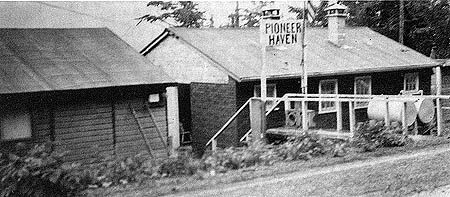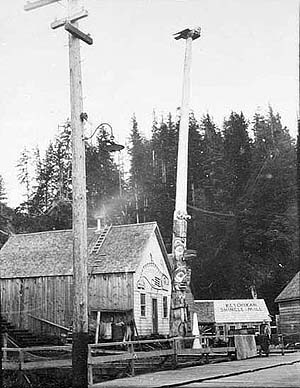 By June Allen June 27, 2002
Try to picture Ketchikan in the summer of 1917. From the water, the downtown and Newtown sections would appear much as they do today. Long-legged docks with fishing boats and workboats bobbing on the tide, rain-scoured wooden buildings lining the waterfront, bursts of steam from canneries, houses hugging the hillsides, and Deer Mountain poking its modest peak toward passing clouds. Instead of cruise ships, there were steamships with passengers - including tourists, and cargo being offloaded on the dock's crowded and bustling splintered planks. The waterfront smelled strongly of saltwater sealife and fish offal from the canneries, which, the locals say, "smells like money!" Ashore, in 1917 the town boasted wall-to-wall false-front wooden buildings, with a bank and two sturdy mercantiles built of concrete, speaking to the town's modern attitudes and its prosperity. There were churches with spires and belfries, a firehouse with a hose tower, and two elegant hotels with commanding cupolas serving as landmarks. Plank streets rattled with the traffic of new-fangled motor vehicles. A significant number of tourists trodding the
In the summer of 1917 Front Street was uncharacteristically quiet. As of Jan. 1 of that year, the Territory's Bone Dry Law went into effect, three years before the rest of the nation would face the years of "the great experiment that failed" - national Prohibition. But there was still drinking. Ketchikan had faced dry laws in the past and knew the ropes for circumventing them. Closed saloons now posed as confectioneries or other businesses. Home brew and smuggled hard liquors were readily available. The crews of fishing boats crowding the docks during fishing seasons clumped down red-light Creek Street's boardwalks for alcoholic refreshment and entertainment. But regular hometown folks - population nearing 2,000 - were a different story. They might drink, play cards and smell of tobacco, but they tipped their hats when meeting ladies on sidewalk strolls and they didn't curse in front of women. They attended church and belonged to fraternal organizations - and both churches and lodges were an important part of the town's functioning in the early years of the century. Eighty-five years ago, lodges took care of many functions that are tax-supported today, such as the cemetery, help for the needy, care for widows and orphans and the elderly. When the Territorial Legislature in 1915 started making available old age pensions, Ketchikan organized its own Pioneers of Alaska igloo to prove members' eligibility for benefits. On June 22, 1917, the first meeting of the soon-to-be Pioneers of Alaska, Ketchikan Igloo #16, was held at the Red Men Hall, then located at the corner of Main and Dock Streets. Elected president at a second meeting two weeks later was popular physician Henry C. Story. Dr. Story was from Tennessee, a true southern gentleman. He always wore a top hat and as he strolled the wooden sidewalks, he would tip that hat to the ladies and murmur greetings in his soft drawl. The main eligibility for joining the Pioneers of Alaska at that time was residency in Alaska prior to Jan. 1, 1901. (Eligibility requirements would change over the years.) A total of 108 charter members were on the rolls of Ketchikan's Pioneer Igloo #16 when it was officially chartered Jan. 16, 1918. Two years later the membership increased to 225. Four years later Igloo #16 saw the need for a women's auxiliary and Auxiliary #7 was chartered in 1922. That auxiliary accomplished a remarkable feat 25 years later. In 1947, World War II had been over for two years. Ketchikan was growing along with the rest of post-war Alaska and population figures were close to 5,000. The Pioneers Auxiliary #7, with its original members aging, saw the need for eldercare of women in their ranks, especially widows. They hoped to be able to provide free rental homes for pensioned pioneer women. Then Wanda Zimmerman, a charter member of the Auxiliary, willed to the Auxiliary 14 acres "just north of Smiley's Cannery on Tongass Avenue" - today's Wolf Point - for the purpose of establishing a haven for pensioned pioneer women. The property consisted of three buildings containing three furnished units and a cabin. The property overlooked Tongass Narrows. Mellanie Isner and Karla Sunderland both remember being taken there as children to visit elderly ladies who lived there. Wanda was the widow of pioneer merchant Nicholas F. Zimmerman. He and Wanda had come to Ketchikan in 1899 with the exodus from Wrangell of Gold Rush hopefuls in the Stikine area. He sold his goods out of a tent on Dock Street at the turn of the century but later became the owner "of large property holdings in Ketchikan," according to his 1928 obituary. Zimmerman's later store was in the Zimmerman Building on Front Street, now occupied by the Gateway Borough offices. It later became the location of a grocery store owned by Paul Wingren, who said that Wanda Zimmerman rented out rooms on the upper floor of the building in those days. The Pioneers Auxiliary was thrilled with the property but had to find a way to finance such an ambitious undertaking as free housing for the elderly. Mrs. H. P. (Christy) Hansen established the Jumble Shop across the street from the Salvation Army on Stedman Street. She donated her labor and bus fare and kept the shop open for the next ten years! The proceeds kept the senior housing - called Pioneerhaven - open and occupied. She was assisted by Maude Williams, Mrs. Strutz, Mrs. Wall and Fern Johnson, according to Auxiliary records.  Historical Photo Courtesy of the Tongass Historical Society Mrs. Hansen wrote in a 1962 Pioneers annual meeting booklet, "During the past 15 years Pioneerhaven has housed more than nine women and a famous homeless donkey named 'Dammit.'" (Dammit's story will be in subsequent story in Sitnews.) There was help from every quarter in the community. The newly founded Ketchikan VFW donated a hut for an outbuilding. Carpenters, plumbers and electricians donated their labor. A dam was built on a creek on the upland side of the road to being gravity flow water into the housing units. Almer Wolff lived across the road from Pioneerhaven (thus the name Wolf Point, misspelled). He took care of garbage for the ladies. When the water pipes froze in the winter, he carried water for them until he built a 5,000-gallon tank on his upland property and piped water into Pioneerhaven and electrified the pipes to keep them thawed in the winter. Almer Wolff was the owner of the thriving Shamrock Bar on Stedman Street, across from Thomas Basin, back when it was a fishermen's bar with a sign over door that said, in effect, "Through these doors pass the greatest fishermen in the world." That was years before the Shamrock became a girlie bar under a different owner, and was finally closed and eventually demolished. The grand opening of Pioneerhaven was held on Labor Day 1948 when two units were ready for occupancy. Mitch Spaeth donated a building which was set up as a fourth unit. The first two units, according to Mrs. Hansen's records, "consisted of a large living room and the third had a bedroom. All had bathrooms. Furniture was donated." At first the tenants had to pay for heating oil and utilities. Later the Pioneers paid for the utilities, possibly financed in part by the proceeds of the sale of the 14-acre property's timber which was sold to a local firm, according to records. The first occupants were "Mrs. Olsen, mother of well-known Bill Olsen. Mrs. Anne Hoguewood who was replaced by Myra Fraser, and Abbie Henning, who had the largest apartment," according to Mrs. Hansen's records. As if these massive grassroots accomplishments weren't enough, when Mrs. Elsie Robinson gave the Pioneers her house at 1118 Water Street, it was with the stipulation that the Pioneers pay the living and hospital expenses of her husband. That was done until a place was found for Mr. Robinson at the Pioneers Home in Sitka. There were, in addition, attorney fees of $3,000 - paid for with $1,000 from the Auxiliary, $1,000 from its jumble shop, and a $1,000 loan from Marie Ferry (the late Ted Ferry's mother). Jesta Williams, Jeanne Traversy and Margaret Collins all worked as manager of the Water Street facility. But there were other unexpected problems with the Water Street property which underscored the struggles of volunteer organizations in providing needed services to segments of society. Fortunately, a women's Pioneer Home opened in Sitka in 1950, relieving the local need to provide from the shoulders of volunteers. But if ever the spirit of Ketchikan, then or now, is questioned - here is a classic example of what one small town on Revilla Island can do when it makes up its mind to do so. Three cheers for the Pioneers of Alaska Igloo #16 and its incredible Auxiliary #7!
Historical Photos Courtesy of the Ketchikan Museums & the Tongass Historical Society.
|
||
